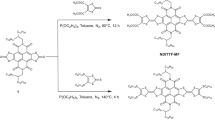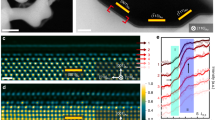Abstract
Understanding chemical bonding and conductivity at the electrode–molecule interface is key for the operation of single-molecule junctions. Here we apply the d-band theory that describes interfacial interactions between adsorbates and transition metal surfaces to study electron transport across these devices. We realized bimetallic Au electrodes modified with a monoatomic Ag adlayer to connect α,ω-alkanoic acids (HO2C(CH2)nCO2H). The force required to break the molecule–electrode binding and the contact conductance Gn=0 are 1.1 nN and 0.29 G0 (the conductance quantum, 1 G0 = 2e2/h ≈ 77.5 μS), which makes these junctions, respectively, 1.3–1.8 times stronger and 40–60-fold more conductive than junctions with bare Au or Ag electrodes. A similar performance was found for Au electrodes modified by Cu monolayers. By integrating the Newns–Anderson model with the Hammer–Nørskov d-band model, we explain how the surface d bands strengthen the adsorption and promote interfacial electron transport, which provides an alternative avenue for the optimization of molecular electronic devices.
This is a preview of subscription content, access via your institution
Access options
Access Nature and 54 other Nature Portfolio journals
Get Nature+, our best-value online-access subscription
$29.99 / 30 days
cancel any time
Subscribe to this journal
Receive 12 print issues and online access
$259.00 per year
only $21.58 per issue
Buy this article
- Purchase on Springer Link
- Instant access to full article PDF
Prices may be subject to local taxes which are calculated during checkout




Similar content being viewed by others
Data availability
The data that support the findings of this study are available from the corresponding author upon reasonable request. Source data are provided with this paper.
Code availability
The algorithm that was used to calculate the quantum transport properties is available from the corresponding author upon reasonable request.
References
Jia, C. & Guo, X. Molecule–electrode interfaces in molecular electronic devices. Chem. Soc. Rev. 42, 5642–5660 (2013).
Huang, M.-J. et al. Conductance of tailored molecular segments: a rudimentary assessment by Landauer formulation. J. Am. Chem. Soc. 136, 1832–1841 (2014).
Karthäuser, S. Control of molecule-based transport for future molecular devices. J. Phys. Condens. Matter 23, 013001 (2011).
Sun, L. et al. Single-molecule electronics: from chemical design to functional devices. Chem. Soc. Rev. 43, 7378–7411 (2014).
Hammer, B. & Nørskov, J. K. Why gold is the noblest of all the metals. Nature 376, 238 (1995).
Zhao, Z.-J. et al. Theory-guided design of catalytic materials using scaling relationships and reactivity descriptors. Nat. Rev. Mater. 4, 792–804 (2019).
Nørskov, J. K., Bligaard, T., Rossmeisl, J. & Christensen, C. H. Towards the computational design of solid catalysts. Nat. Chem. 1, 37–46 (2009).
Ross, M. B. et al. Tunable Cu enrichment enables designer syngas electrosynthesis from CO2. J. Am. Chem. Soc. 139, 9359–9363 (2017).
Nørskov, J. K., Abild-Pedersen, F., Studt, F. & Bligaard, T. Density functional theory in surface chemistry and catalysis. Proc. Natl Acad. Sci. USA 108, 937–943 (2011).
Anderson, P. W. Localized magnetic states in metals. Phys. Rev. 124, 41–53 (1961).
Newns, D. M. Self-consistent model of hydrogen chemisorption. Phys. Rev. 178, 1123–1135 (1969).
Hammer, B. & Nørskov, J. K. Theoretical surface science and catalysis—calculations and concepts. Adv. Catal. 45, 71–129 (2000).
Vojvodic, A., Nørskov, J. K. & Abild-Pedersen, F. Electronic structure effects in transition metal surface chemistry. Top. Catal. 57, 25–32 (2014).
Rodriguez, J. A. Physical and chemical properties of bimetallic surfaces. Surf. Sci. Rep. 24, 223–287 (1996).
Greiner, M. T. et al. Free-atom-like d states in single-atom alloy catalysts. Nat. Chem. 10, 1008–1015 (2018).
Herrero, E., Buller, L. J. & Abruña, H. D. Underpotential deposition at single crystal surfaces of Au, Pt, Ag and other materials. Chem. Rev. 101, 1897–1930 (2001).
Chen, I-W. P., Chen, C.-C., Lin, S.-Y. & Chen, C.-h. Effect of underpotentially deposited adlayers on sulfur bonding schemes of organothiols self-assembled on polycrystalline gold: sp or sp3 hybridization. J. Phys. Chem. B 108, 17497–17504 (2004).
Chen, F., Li, X., Hihath, J., Huang, Z. & Tao, N. J. Effect of anchoring groups on single-molecule conductance: comparative study of thiol-, amine-, and carboxylic-acid-terminated molecules. J. Am. Chem. Soc. 128, 15874–15881 (2006).
Chen, I-W. P. et al. Tactile-feedback stabilized molecular junctions for the measurement of molecular conductance. Angew. Chem. Int. Ed. 52, 2449–2453 (2013).
Ahn, S. et al. Electronic transport and mechanical stability of carboxyl linked single-molecule junctions. Phys. Chem. Chem. Phys. 14, 13841–13845 (2012).
Haiss, W. et al. Precision control of single-molecule electrical junctions. Nat. Mater. 5, 995–1002 (2006).
Li, C. et al. Charge transport in single Au|alkanedithiol|Au junctions: coordination geometries and conformational degrees of freedom. J. Am. Chem. Soc. 130, 318–326 (2008).
Xu, B., Xiao, X. & Tao, N. J. Measurements of single-molecule electromechanical properties. J. Am. Chem. Soc. 125, 16164–16165 (2003).
Ko, C.-H., Huang, M.-J., Fu, M.-D. & Chen, C.-h. Superior contact for single-molecule conductance: electronic coupling of thiolate and isothiocyanate on Pt, Pd, and Au. J. Am. Chem. Soc. 132, 756–764 (2010).
Guo, S., Hihath, J., Díez-Pérez, I. & Tao, N. Measurement and statistical analysis of single-molecule current–voltage characteristics, transition voltage spectroscopy, and tunneling barrier height. J. Am. Chem. Soc. 133, 19189–19197 (2011).
Lin, S.-Y. et al. Structures of self-assembled monolayers of n-alkanoic acids on gold surfaces modified by underpotential deposition of silver and copper: odd−even effect. Langmuir 18, 5473–5478 (2002).
Xie, Z., Bâldea, I. & Frisbie, C. D. Energy level alignment in molecular tunnel junctions by transport and spectroscopy: self-consistency for the case of alkyl thiols and dithiols on Ag, Au, and Pt electrodes. J. Am. Chem. Soc. 141, 18182–18192 (2019).
Xie, Z., Bâldea, I. & Frisbie, C. D. Determination of energy-level alignment in molecular tunnel junctions by transport and spectroscopy: self-consistency for the case of oligophenylene thiols and dithiols on Ag, Au, and Pt electrodes. J. Am. Chem. Soc. 141, 3670–3681 (2019).
Xie, Z., Bâldea, I., Smith, C. E., Wu, Y. & Frisbie, C. D. Experimental and theoretical analysis of nanotransport in oligophenylene dithiol junctions as a function of molecular length and contact work function. ACS Nano 9, 8022–8036 (2015).
Bâldea, I. Ambipolar transition voltage spectroscopy: analytical results and experimental agreement. Phys. Rev. B 85, 035442 (2012).
Xiang, A. et al. The origin of the transition voltage of gold–alkanedithiol–gold molecular junctions. Chem. Phys. 465−466, 40–45 (2016).
Nose, D. et al. Effects of interface electronic structures on transition voltage spectroscopy of alkanethiol molecular junctions. J. Phys. Chem. C 119, 12765–12771 (2015).
Ricœur, G., Lenfant, S., Guérin, D. & Vuillaume, D. Molecule/electrode interface energetics in molecular junction: a ‘transition voltage spectroscopy’ study. J. Phys. Chem. C 116, 20722–20730 (2012).
Huisman, E. H., Guédon, C. M., van Wees, B. J. & van der Molen, S. J. Interpretation of transition voltage spectroscopy. Nano Lett. 9, 3909–3913 (2009).
Baldea, I. Important issues facing model-based approaches to tunneling transport in molecular junctions. Phys. Chem. Chem. Phys. 17, 20217–20230 (2015).
Martín, S. et al. Adverse effects of asymmetric contacts on single molecule conductances of HS(CH2)nCOOH in nanoelectrical junctions. Nanotechnology 20, 125203 (2009).
Al-Owaedi, O. A. et al. Insulated molecular wires: inhibiting orthogonal contacts in metal complex based molecular junctions. Nanoscale 9, 9902–9912 (2017).
Jones, B. A., Facchetti, A., Wasielewski, M. R. & Marks, T. J. Tuning orbital energetics in arylene diimide semiconductors. Materials design for ambient stability of n-type charge transport. J. Am. Chem. Soc. 129, 15259–15278 (2007).
Cercellier, H. et al. Interplay between structural, chemical, and spectroscopic properties of Ag/Au(111) epitaxial ultrathin films: a way to tune the Rashba coupling. Phys. Rev. B 73, 195413 (2006).
CRC Handbook of Chemistry and Physics 100th edn (CRC, 2020).
Cuevas, J. C. & Scheer, E. Molecular Electronics: An Introduction to Theory and Experiment 2nd edn (World Scientific, 2017).
Datta, S. Quantum Transport: Atom to Transistor (Cambridge Univ. Press, 2005).
Helander, M. G., Greiner, M. T., Wang, Z. B. & Lu, Z. H. Angle-dependent ultraviolet photoelectron spectroscopy of sputter cleaned polycrystalline noble metals. Appl. Surf. Sci. 255, 9553–9556 (2009).
Shapiro, A. P., Hsieh, T. C., Wachs, A. L., Miller, T. & Chiang, T.-C. Band dispersions of Ag(111) monolayers on various substrates. Phys. Rev. B 38, 7394–7407 (1988).
Peng, Z.-L. et al. Single molecule conductance of carboxylic acids contacting Ag and Cu electrodes. J. Phys. Chem. C 116, 21699–21705 (2012).
Wang, Y.-H. et al. Tunneling decay constant of alkanedicarboxylic acids: different dependence on the metal electrodes between air and electrochemistry. J. Phys. Chem. C 118, 18756–18761 (2014).
Frei, M., Aradhya, S. V., Hybertsen, M. S. & Venkataraman, L. Linker dependent bond rupture force measurements in single-molecule junctions. J. Am. Chem. Soc. 134, 4003–4006 (2012).
Park, Y. S. et al. Contact chemistry and single-molecule conductance: a comparison of phosphines, methyl sulfides, and amines. J. Am. Chem. Soc. 129, 15768–15769 (2007).
Frei, M., Aradhya, S. V., Koentopp, M., Hybertsen, M. S. & Venkataraman, L. Mechanics and chemistry: single molecule bond rupture forces correlate with molecular backbone structure. Nano Lett. 11, 1518–1523 (2011).
Zhou, X.-S. et al. Extending the capability of STM break junction for conductance measurement of atomic-size nanowires: an electrochemical strategy. J. Am. Chem. Soc. 130, 13228–13230 (2008).
Acknowledgements
The authors are grateful to C.-H. Lin (NTU) and L.-Y. Hsu (IAMS, Academia Sinica) for fruitful discussions and to F.-M. Chen for the graphic drawing. Thanks to S.-J. Ji of the Ministry of Science and Technology (MOST) for the characterization of UPD-modified AFM tips by SEM. This research is supported by MOST (109-2628-M-143-001-MY3, 108-2113-M-002-007-MY3 and 106-2113-M-032-005) and by NTU (108L880115). H.H.P. thanks NTU for a University Fellowship.
Author information
Authors and Affiliations
Contributions
C.-h.C. conceived the idea. M.-W.G. developed the theoretical model. M.-W.G. and H.H.P. performed the experiments and the data were analysed by M.-W.G., H.H.P. and I-W.P.C. I-W.P.C. and C.-h.C. supervised the research. The manuscript was written through contributions from all authors.
Corresponding authors
Ethics declarations
Competing interests
The authors declare no competing interests.
Additional information
Peer review information Nature Materials thanks Thomas Frederiksen and the other, anonymous, reviewer(s) for their contribution to the peer review of this work.
Publisher’s note Springer Nature remains neutral with regard to jurisdictional claims in published maps and institutional affiliations.
Supplementary information
Supplementary Information
Supplementary Discussion, Figs. 1–10, Tables 1–5, glossary and refs. 1–75.
Source data
Source Data Fig. 2
Numerical data used to generate the graphs displayed in panels a–c.
Source Data Fig. 3
Numerical data used to generate the graphs displayed in panels a and b.
Source Data Fig. 4
Numerical data used to generate the graphs displayed in panels c–e and h–j.
Rights and permissions
About this article
Cite this article
Gu, MW., Peng, H.H., Chen, IW.P. et al. Tuning surface d bands with bimetallic electrodes to facilitate electron transport across molecular junctions. Nat. Mater. 20, 658–664 (2021). https://doi.org/10.1038/s41563-020-00876-2
Received:
Accepted:
Published:
Issue Date:
DOI: https://doi.org/10.1038/s41563-020-00876-2
This article is cited by
-
Molecular Junctions: Introduction and Physical Foundations, Nanoelectrical Conductivity and Electronic Structure and Charge Transfer in Organic Molecular Junctions
Brazilian Journal of Physics (2022)
-
Bimetallic electrodes boost molecular junctions
Nature Materials (2021)
-
A single atom change turns insulating saturated wires into molecular conductors
Nature Communications (2021)



